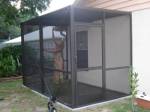Since we moved in we have completely remodeled the kitchen, replaced the flooring(already replaced once due to a burst water pipe), redone the master bath, and replaced some furniture. Will my Condo insurance policy cover my improved home?
And exactly what does a typical policy cover and is the coverage enough?
An HO6 homeowner’s policy has 5 basic areas of coverage:
Dwelling Coverage- covers your unit’s walls, ceilings, and floors. Some building master policies cover your unit as well, so you might not need to insure for the full replacement cost. There is a larger deductible on the master policy, however, and most unit owners do carry around $10,000 of dwelling coverage.
Dwelling Coverage Insurance companies offer Dwelling Coverage, which generally insures the interior walls, drywall, wallpaper, paneling, flooring, carpeting, or built-in cabinets. This is the coverage you need to cover your part of the building; the unit you own.
As a condo association, you all take responsibility and ownership for the common areas, the exterior of the building, and energy equipment. The interior of your unit, however, is your responsibility, and it is important to make sure your real estate investment is protected.
Note: Some condo “Master Policies” provide all-in coverage. This means the entire building, including your unit, are covered. Check your condos Master Policy and find our if it covers your individual unit. If the Master Policy doesn’t cover your unit, you need individual Dwelling Coverage.
Dwelling Coverage usually covers damage resulting from:
* Freezing of plumbing * Accidental discharge or overflow of water from your plumbing * Fire and lightning * Explosions * Theft, vandalism and malicious mischief * Sudden, accidental damage from smoke * Weight of snow, ice and sleet * Sudden, accidental tearing, cracking, burning or bulging of a steam pipe or hot water heating system
Dwelling does not cover damage caused by:
* Earthquakes, floods, and in many states, hurricanes. If you want to insure your Condo against these risks, you may be able to buy an additional policy or endorsement for each of these. * Theft by someone named on your Condo policy as an insured party.
Do I need dwelling coverage for my unit?
* As noted above, your condo building Master Policy might have coverage for your unit. Find out if you have coverage and, if so, how much coverage and at what deductible.
Important note on condo docs: In some rare cases, your condo documents might say something different than your Master Policy. If your Master Policy says your unit is insured for dwelling, but your condo docs say otherwise, the condo docs win. A claim adjuster would default to what the condo docs say, and you wouldn’t have coverage. Make sure your condo docs state the same coverage as your Master Policy.
* If you have no coverage with your building policy, you should purchase dwelling coverage for the full replacement amount.
Even if your building Master Policy provides some coverage for your unit, most condo owners still like to take out dwelling coverage for their specific unit, often around $10,000 with a $500 deductible. This is due to master policy limits, high deductibles, and condo document discrepancies (see above).
Personal Property- covers your personal property such as clothing, electronics, furniture, fixtures, books, artwork, etc. The building master policy does not cover this. A home inventory is very important to prove ownership of personal property
Personal Property Personal Property Coverage typically protects your personal belongings against the same list of risks and perils mentioned in Dwelling Coverage of Condo Policies Part 1.
Your personal property is not covered by a condo master policy, and you should protect it. Unlike dwelling coverage, where the building policy might provide some coverage, your personal property is at risk.
Personal property includes everything you own in your home. Furniture, TVs, computers, rugs, clothing, books, cookware, etc. Everything that is not attached to your condo is personal property and it should be insured. See our home inventory page for details about documenting your personal property.
How Much Coverage Is Enough?
There are a couple ways to determine how much coverage you need. The question is difficult: what is the replacement cost of everything you own? Most often, homeowners undervalue their property which results in them under-insuring their property.
One method is to individually value each item in your home. This means taking an entire inventory of your home, and assigning a value to each item. Many homeowners also like to take pictures, or even a video, of their home to keep on file in case of a loss.
Another method of determining your personal property value is to use a simple multiplier. As a rule of thumb, for the first 1,000 square feet of your condo, assume $40,000 in personal property. For each additional 500 square feet, add approximately $5,000 in coverage.
Example: If your unit were 1,500 square feet you would want to consider purchasing $45,000 in personal property coverage.
Unless otherwise specified, Coverage C – Personal Property Coverage is for actual cash value at the time of loss, which is the replacement cost of the item, minus depreciation. Buying an endorsement can increase this coverage.
Do you need more than actual cash value coverage for your personal belongings?
We recommend replacement coverage for your personal property, rather than actual cash value. If you purchased most of your belongings a few years ago, their current depreciated value may be a lot less than what it would take to replace them.
Example: If your television is damaged in a fire, actual cash value coverage pays out the amount of money your 10-year-old TV would be worth today, which may only be a few dollars. Replacement cost coverage would pay for a new TV of the same size and functions. This is why replacement cost coverage is always better than actual cash value.
If you have personal property such as firearms, jewelry, furs, antiques, collectibles, fine artwork, musical instruments or office equipment, you may need additional coverage. A standard condo policy usually has specific dollar limits for items like these. You can add or increase coverage amounts with an endorsement or additional policy.
Loss of Use- if you home is damaged and needs repair, you will need someplace to live. Loss of use coverage pays for living expenses while your home is being repaired.
Loss of Use If a loss occurs and your home is damaged, it will take some time to renovate your home. During this time, you will probably need somewhere else to live while the work is being done. How will you pay for additional living expenses while your condo is being fixed?
Loss of Use Coverage will insure you for temporary housing expenses such as an apartment rental. Loss of use coverage will also cover things like furniture, car and boat storage, and even pet kennel expenses.
The Loss of Use coverage usually has a limit based on a percentage of the Personal Property limit, often around 40%. For example: if you insure Personal Property for $30,000, your Loss of Use coverage limit would be $12,000 (40% of $30,000).
Personal Liability- covers you from personal liability claims. The classic example is a “slip & fall” in your home, and you get sued. The list goes on and on, which shows how important it is to have enough liability coverage.
Personal Liability One of the most important parts of a condo insurance policy is the Personal Liability Coverage. This will cover you against lawsuits, legal expenses, and medical costs if you are legally responsible for injury or property damage to others. The coverage here is variable, but most insurance professionals recommend $500,000.
Medical Payments- if a person is injured in your home, and is not named on your policy, this would pay for minor medical payments.
Medical Payments If a person is injured in your condo, and they are not named on your policy, this coverage would pay for some minor medical treatment, such as exams or X-rays. Generally, this coverage is fairly low, but provides the insured with means to cover minor medical expenses without filing a claim against the Personal Liability Coverage portion of the HO6.
Do I have enough coverage? I will discuss this with my insurance company soon.
.





